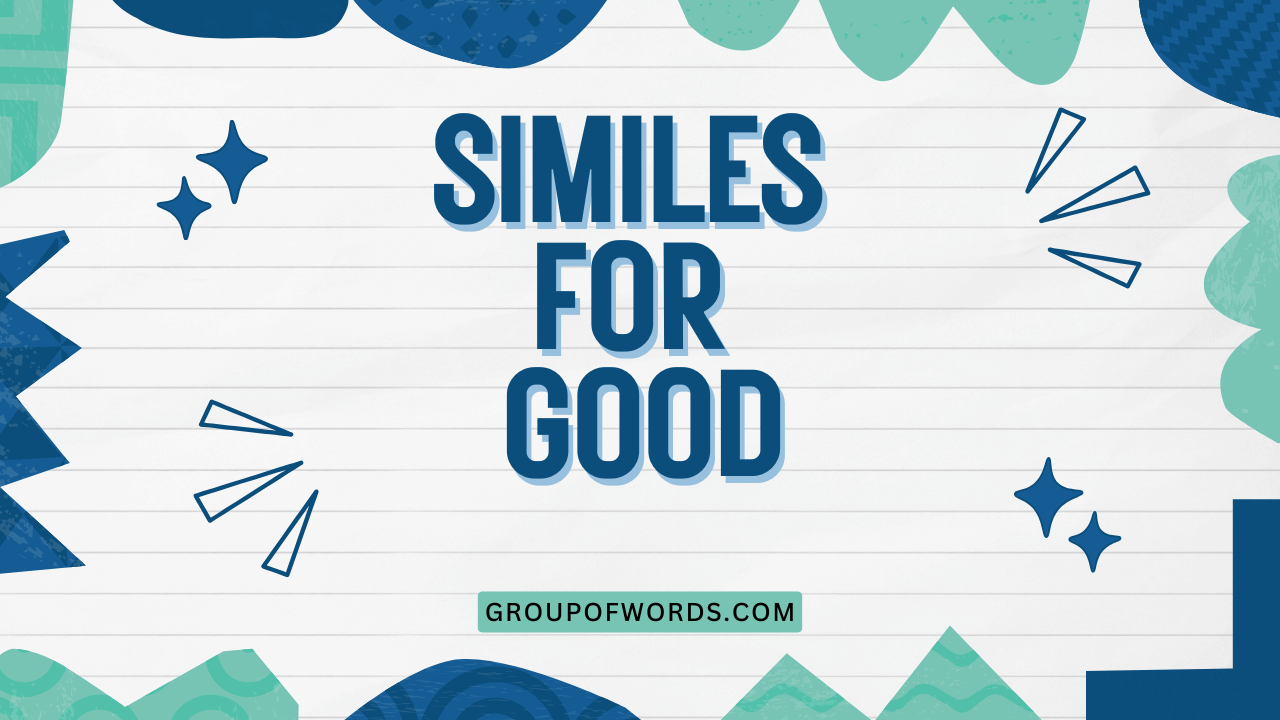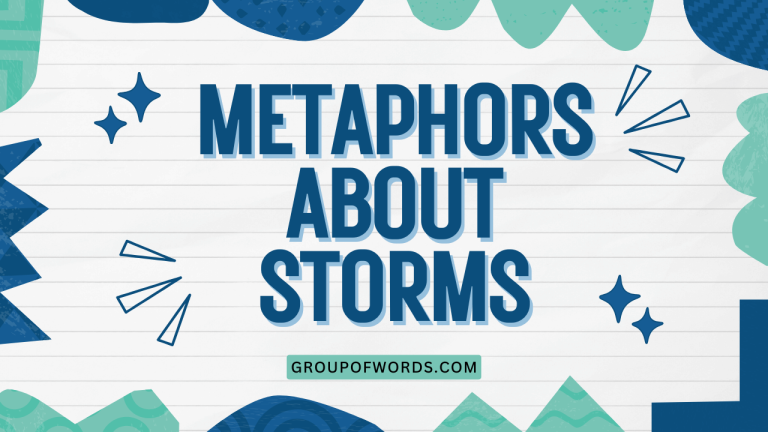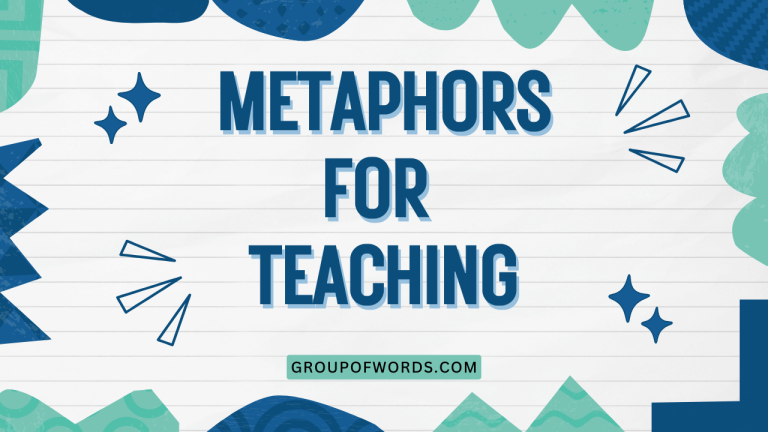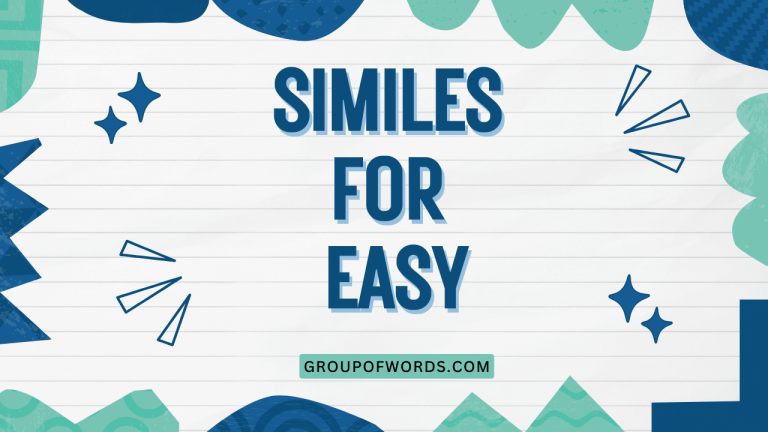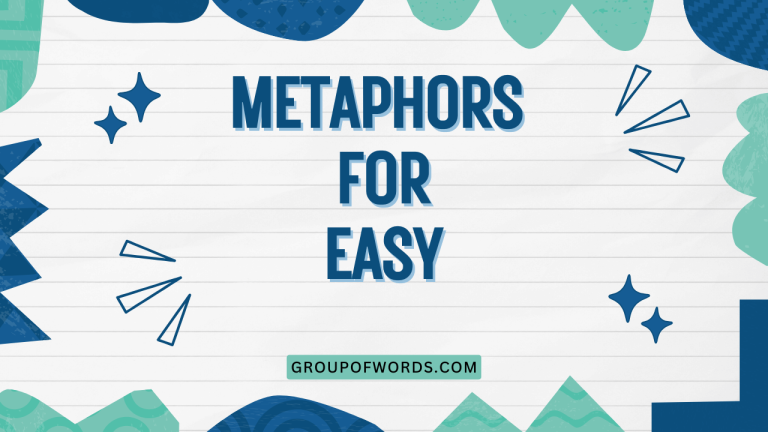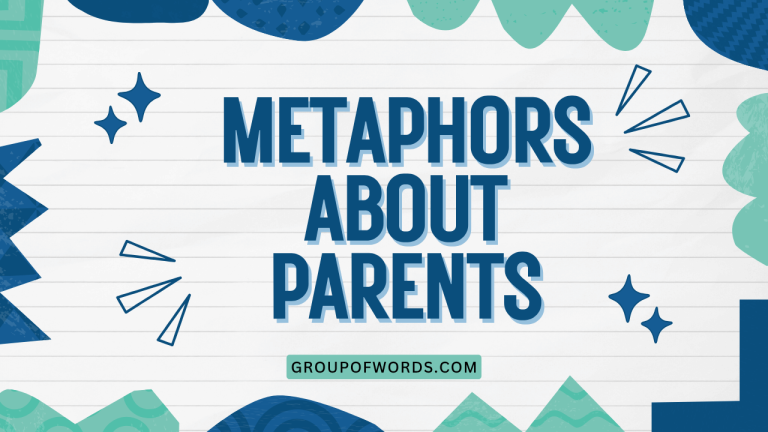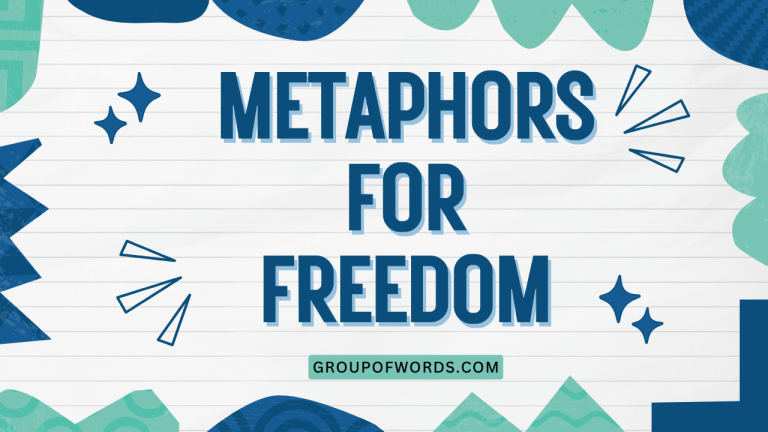Similes for Good: Enhancing Your Writing with Positive Comparisons
Similes, powerful tools in the English language, allow us to draw vivid comparisons between two unlike things using words like “like” or “as.” Mastering similes, especially those that evoke positive imagery and convey goodness, can significantly enhance your writing and communication skills. This article provides a comprehensive guide to understanding and using similes for good, exploring their definition, structure, types, and usage rules.
Whether you’re a student, writer, or language enthusiast, this guide will equip you with the knowledge and practice you need to effectively incorporate similes into your vocabulary and writing.
This article will benefit students looking to improve their writing skills, writers seeking to add depth and imagery to their work, and ESL learners aiming to master figurative language. By understanding similes, you can express ideas more creatively and impactfully, making your writing more engaging and memorable.
Table of Contents
- Introduction
- Definition of Similes for Good
- Structural Breakdown of Similes
- Types of Similes for Good
- Examples of Similes for Good
- Usage Rules for Similes
- Common Mistakes with Similes
- Practice Exercises
- Advanced Topics in Similes
- Frequently Asked Questions (FAQ)
- Conclusion
Definition of Similes for Good
A simile is a figure of speech that compares two different things using the words “like” or “as.” The purpose of a simile is to create a vivid image or convey a specific quality by associating it with something else that shares a similar characteristic. When we talk about “similes for good,” we specifically refer to similes that use comparisons to describe positive qualities, virtues, or beneficial attributes. These similes often evoke feelings of admiration, appreciation, or inspiration.
Similes function by drawing a parallel between two seemingly unrelated subjects. The comparison highlights a shared quality, making the description more engaging and understandable.
In the context of “good,” these similes often describe attributes such as kindness, bravery, intelligence, beauty, peace, and other positive characteristics. For example, saying someone is “as brave as a lion” uses the lion’s well-known courage to emphasize the person’s bravery.
The context in which a simile is used is crucial. A well-chosen simile can add depth and nuance to your writing, making it more impactful and memorable.
However, a poorly chosen simile can be confusing or even detract from your message. Therefore, it’s important to carefully consider the connotations of the things you are comparing and how they will be perceived by your audience.
Structural Breakdown of Similes
Similes typically follow a simple structure: Subject + Linking Word (like/as) + Object of Comparison. Understanding this structure is essential for creating effective similes.
Let’s break down each component:
- Subject: This is the person, thing, or idea being described.
- Linking Word: This is either “like” or “as.” These words explicitly signal that a comparison is being made.
- Object of Comparison: This is the person, thing, or idea that the subject is being compared to. The object of comparison should possess a quality that you want to emphasize in the subject.
For example, in the simile “She is as gentle as a lamb,” “She” is the subject, “as” is the linking word, and “a lamb” is the object of comparison. The simile suggests that she possesses the quality of gentleness, just like a lamb.
The effectiveness of a simile depends on the clarity and relevance of the comparison. The object of comparison should be something that your audience is familiar with and that clearly embodies the quality you are trying to convey.
If the comparison is obscure or confusing, the simile will lose its impact.
Here’s a table illustrating the structural breakdown with additional examples:
| Subject | Linking Word | Object of Comparison | Simile |
|---|---|---|---|
| His heart | was like | a warm fire | His heart was like a warm fire. |
| Her smile | is as | bright as the sun | Her smile is as bright as the sun. |
| The child’s innocence | was like | a fresh snowfall | The child’s innocence was like a fresh snowfall. |
| His wisdom | is as | deep as the ocean | His wisdom is as deep as the ocean. |
| Her voice | was like | a gentle breeze | Her voice was like a gentle breeze. |
| The artist’s creativity | is like | a boundless universe | The artist’s creativity is like a boundless universe. |
| Their friendship | is as | strong as steel | Their friendship is as strong as steel. |
| The leader’s vision | was like | a guiding star | The leader’s vision was like a guiding star. |
| Her compassion | is as | vast as the sky | Her compassion is as vast as the sky. |
| The hero’s courage | was like | an unyielding mountain | The hero’s courage was like an unyielding mountain. |
Types of Similes for Good
While all similes for good share the common goal of describing positive attributes, they can be categorized based on the specific qualities they emphasize. Here are some common types of similes for good:
- Similes for Kindness: These similes describe gentleness, compassion, and empathy.
- Similes for Bravery: These similes highlight courage, strength, and resilience.
- Similes for Intelligence: These similes emphasize wisdom, knowledge, and understanding.
- Similes for Beauty: These similes describe physical attractiveness, grace, and elegance.
- Similes for Peace: These similes evoke tranquility, harmony, and serenity.
Similes for Kindness
Similes for kindness aim to evoke feelings of warmth, compassion, and gentleness. They often compare people or actions to things that are inherently kind or nurturing.
Examples:
- She is as gentle as a lamb.
- His words were like a soothing balm.
- Her heart is like a warm fire on a cold night.
Similes for Bravery
Similes for bravery highlight courage, strength, and the ability to face challenges fearlessly. They often compare people or actions to things that are known for their strength or resilience.
Examples:
- He is as brave as a lion.
- Her spirit is like an unyielding mountain.
- His determination was like a raging fire.
Similes for Intelligence
Similes for intelligence emphasize wisdom, knowledge, and the ability to understand complex ideas. They often compare people or their minds to things that are vast, deep, or insightful.
Examples:
- Her mind is as sharp as a razor.
- His wisdom is like a deep well.
- Her insights were like guiding stars.
Similes for Beauty
Similes for beauty describe physical attractiveness, grace, and elegance. They often compare people or things to elements of nature that are considered beautiful or to objects that are aesthetically pleasing.
Examples:
- She is as beautiful as a rose.
- Her voice is like a nightingale’s song.
- Her eyes are like sparkling jewels.
Similes for Peace
Similes for peace evoke tranquility, harmony, and serenity. They often compare situations or feelings to things that are inherently calm and soothing.
Examples:
- The silence was like a gentle snowfall.
- Her presence is like a calming breeze.
- The atmosphere was as peaceful as a sleeping lake.
Examples of Similes for Good
This section provides an extensive collection of similes for good, categorized by the positive qualities they describe. Each category includes a variety of examples to illustrate the versatility and impact of similes in expressing positive attributes.
Similes for Kindness
Kindness is a virtue that enriches our lives and the lives of those around us. Similes can beautifully capture the essence of kindness, highlighting its gentle and compassionate nature.
The following table contains examples of similes that describe kindness.
| Simile | Explanation |
|---|---|
| Her heart is like a warm blanket on a cold day. | This simile suggests that her kindness provides comfort and warmth to those in need. |
| His words were as gentle as a summer breeze. | This simile indicates that his communication is soothing and non-threatening. |
| She is as compassionate as a mother tending to her child. | This simile emphasizes her nurturing and caring nature. |
| His actions were like a helping hand extended to a stranger. | This simile highlights his willingness to assist others in need. |
| Her smile is as bright as the sun, warming everyone around her. | This simile suggests that her kindness is radiant and uplifting. |
| His generosity is like a river flowing freely, giving life to all. | This simile emphasizes the abundance and life-giving quality of his kindness. |
| Her empathy is as deep as the ocean, understanding the pain of others. | This simile highlights her ability to deeply understand and share the feelings of others. |
| His forgiveness is like a clean slate, offering a fresh start to those who err. | This simile emphasizes the restorative and liberating power of forgiveness. |
| Her patience is as endless as the sky, never tiring of helping others. | This simile suggests that her kindness is unwavering and persistent. |
| His understanding is like a bridge connecting people from different backgrounds. | This simile highlights his ability to foster connection and understanding between diverse individuals. |
| Her support is like a sturdy tree, providing strength and stability. | This simile emphasizes the reliable and unwavering nature of her support. |
| His encouragement is as uplifting as a soaring eagle, inspiring others to reach new heights. | This simile suggests that his kindness motivates and empowers others. |
| Her tolerance is like a vast garden, embracing all kinds of flowers. | This simile highlights her acceptance and appreciation of diversity. |
| His acceptance is as unconditional as a mother’s love, embracing imperfections. | This simile emphasizes his ability to accept others without judgment. |
| Her consideration is like a gentle rain, nourishing the spirits of those around her. | This simile suggests that her kindness is refreshing and revitalizing. |
| His thoughtfulness is as comforting as a familiar melody, bringing peace of mind. | This simile highlights his ability to provide solace and reassurance. |
| Her service is like a silent stream, continuously providing for others’ needs. | This simile emphasizes her selfless and continuous dedication to helping others. |
| His compassion is as boundless as the universe, encompassing all living beings. | This simile suggests that his kindness extends to all creatures, without limit. |
| Her goodwill is like a beacon of light, guiding others towards a better path. | This simile highlights her ability to inspire and lead others towards positive change. |
| His generosity is as abundant as a harvest, sharing the fruits of his labor with all. | This simile emphasizes the plentiful and sharing nature of his kindness. |
| Her grace is like a swan gliding on water, elegant and effortless. | This simile describes her kindness as graceful and natural. |
| His sincerity is as clear as a mountain spring, pure and untainted. | This simile highlights the genuine and honest nature of his kindness. |
| Her understanding is like a telescope, bringing distant perspectives into focus. | This simile suggests that her kindness involves seeing things from different viewpoints. |
| His helpfulness is as reliable as the sunrise, always there when needed. | This simile emphasizes the dependable and consistent nature of his kindness. |
Similes for Bravery
Bravery is the quality of facing danger, fear, or difficulty with courage. Similes can powerfully illustrate this virtue, comparing individuals or actions to things known for their strength and resilience.
The following table offers various similes that capture the essence of bravery.
| Simile | Explanation |
|---|---|
| He is as brave as a lion facing its prey. | This classic simile evokes a sense of fearless confrontation. |
| Her spirit is like an unyielding mountain, standing firm against the storm. | This simile emphasizes resilience and unwavering determination. |
| His resolve was as strong as steel, unbreakable under pressure. | This simile highlights the strength and durability of his determination. |
| She is as courageous as a firefighter running into a burning building. | This simile illustrates bravery in the face of immediate danger. |
| His heart is like a warrior’s shield, protecting him from fear. | This simile suggests that his bravery is a defense against negativity. |
| Her bravery is as bright as a flame, illuminating the path for others. | This simile emphasizes the inspiring and guiding nature of her courage. |
| His defiance was like a roaring river, unstoppable in its course. | This simile highlights the powerful and persistent nature of his resistance. |
| She is as fearless as a tightrope walker high above the ground. | This simile evokes a sense of daring and overcoming fear of heights. |
| His will is like a sturdy oak, weathering any storm. | This simile emphasizes the enduring and resilient nature of his will. |
| Her courage is as deep as the ocean, unfathomable and unwavering. | This simile suggests that her bravery is profound and steadfast. |
| His determination is like a marathon runner, pushing through pain to reach the finish line. | This simile highlights the perseverance and endurance required for bravery. |
| She is as bold as an explorer venturing into uncharted territory. | This simile illustrates the adventurous and daring aspect of bravery. |
| His integrity is like a fortress, impenetrable by corruption. | This simile emphasizes the moral strength and resistance to wrongdoing. |
| Her resilience is as strong as bamboo, bending but never breaking. | This simile highlights the ability to recover from adversity. |
| His nerve is like a surgeon’s hand, steady and precise in critical moments. | This simile suggests that his bravery involves skill and precision under pressure. |
| She is as daring as a stunt performer, pushing boundaries and defying limits. | This simile illustrates the willingness to take risks. |
| His valor is like a knight’s armor, protecting the innocent and vulnerable. | This simile emphasizes the protective and selfless nature of his bravery. |
| Her grit is as tough as diamonds, unyielding under immense pressure. | This simile highlights the toughness and determination in the face of challenges. |
| His fortitude is like a mountain climber, scaling the highest peaks despite the odds. | This simile suggests that his bravery involves overcoming significant obstacles. |
| She is as unflinching as a soldier standing guard, unwavering in her duty. | This simile illustrates the steadfastness and commitment to her responsibilities. |
| His spirit is like a phoenix rising from ashes, reborn stronger than before. | This simile describes bravery as the ability to recover and grow from setbacks. |
| Her actions were as decisive as a general’s command, leading to victory. | This simile emphasizes the leadership aspect of bravery, guiding others to success. |
| His heart is as strong as an anchor, holding firm in the face of adversity. | This simile suggests that his bravery provides stability and security. |
| She is as resilient as a rubber band, always bouncing back from challenges. | This simile highlights the ability to recover quickly from difficulties. |
Similes for Intelligence
Intelligence encompasses a wide range of cognitive abilities, including reasoning, problem-solving, and understanding. Similes can beautifully capture the essence of intelligence, highlighting its sharpness, depth, and clarity.
The following table contains examples of similes that describe intelligence.
| Simile | Explanation |
|---|---|
| Her mind is as sharp as a razor, cutting through complexity with ease. | This simile emphasizes the quick and precise nature of her intelligence. |
| His wisdom is like a deep well, providing endless insights and knowledge. | This simile suggests that his intelligence is profound and abundant. |
| She is as insightful as an owl, perceiving things others often miss. | This simile highlights her ability to understand things deeply. |
| His intellect is like a vast library, filled with knowledge from every corner of the world. | This simile emphasizes the breadth and depth of his knowledge. |
| Her understanding is as clear as a crystal, revealing truths with clarity. | This simile suggests that her intelligence provides clarity and transparency. |
| His reasoning is like a well-oiled machine, functioning smoothly and efficiently. | This simile highlights the systematic and effective nature of his thought process. |
| She is as perceptive as an eagle, spotting patterns from afar. | This simile emphasizes her ability to notice subtle details and patterns. |
| His mind is like a sponge, absorbing information quickly and effortlessly. | This simile suggests that his intelligence involves a great capacity for learning. |
| Her knowledge is as expansive as the universe, constantly growing and evolving. | This simile highlights the boundless nature of her knowledge. |
| His thinking is like a chess game, strategic and calculated. | This simile suggests that his intelligence involves careful planning and foresight. |
| She is as astute as a detective, piecing together clues to solve mysteries. | This simile emphasizes her ability to analyze and solve complex problems. |
| His mind is like a computer, processing information rapidly and accurately. | This simile highlights the speed and precision of his cognitive abilities. |
| Her creativity is as boundless as the imagination, generating endless possibilities. | This simile suggests that her intelligence involves a strong creative capacity. |
| His intellect is like a lighthouse, guiding others through the darkness of ignorance. | This simile emphasizes his ability to enlighten and guide others. |
| She is as eloquent as a poet, expressing complex ideas with grace and beauty. | This simile highlights her ability to communicate effectively and persuasively. |
| His understanding is like a telescope, bringing distant perspectives into focus. | This simile suggests that his intelligence involves seeing things from different viewpoints. |
| Her insights are as valuable as gold, enriching our understanding of the world. | This simile emphasizes the precious and beneficial nature of her intelligence. |
| His knowledge is like a well-stocked tool box, providing the resources to tackle any challenge. | This simile suggests that his intelligence equips him to handle various situations. |
| She is as quick-witted as a comedian, responding to situations with humor and intelligence. | This simile highlights her ability to think on her feet and respond cleverly. |
| His mind is like a laboratory, constantly experimenting and discovering new things. | This simile suggests that his intelligence involves a spirit of inquiry and exploration. |
| Her intellect is as reliable as a clock, always providing accurate and timely information. | This simile emphasizes the dependable and consistent nature of her intelligence. |
| His reasoning is like a map, guiding him through complex situations with clarity. | This simile suggests that his intelligence provides direction and guidance. |
| She is as knowledgeable as an encyclopedia, possessing a vast and organized understanding of the world. | This simile highlights the comprehensive and structured nature of her knowledge. |
Usage Rules for Similes
Using similes effectively requires understanding certain rules and guidelines. Here are some key points to keep in mind:
- Clarity: The comparison should be clear and easily understood. Avoid obscure or confusing analogies.
- Relevance: The object of comparison should be relevant to the subject and share a meaningful characteristic.
- Originality: While common similes can be effective, strive for originality to make your writing more engaging.
- Context: Consider the context and audience when choosing a simile. What resonates with one audience may not resonate with another.
- Avoid Clichés: Clichés are overused similes that have lost their impact. Try to find fresh and original comparisons. Examples of clichéd similes are: “as blind as a bat”, “as strong as an ox”, “as quiet as a mouse”.
- Use Sparingly: Overusing similes can make your writing feel forced and unnatural. Use them judiciously to enhance your message.
- Consistency: Ensure that the simile aligns with the overall tone and style of your writing.
It’s also important to consider the connotations of the words you use in your simile. For example, comparing someone to a snake might not be appropriate, even if you intend to convey a positive quality like cunning, because snakes often have negative associations.
Common Mistakes with Similes
Even experienced writers sometimes make mistakes when using similes. Here are some common errors to avoid:
- Mixing Metaphors and Similes: A metaphor states that something *is* something else, while a simile states that something is *like* something else. Avoid blending the two.
- Using Illogical Comparisons: Ensure that the comparison makes sense. Don’t compare things that have no meaningful connection.
- Overusing Similes: Too many similes can clutter your writing and make it less effective.
- Using Clichés: Clichéd similes are overused and lack impact.
Here’s a table illustrating common mistakes with correct and incorrect examples:
| Incorrect | Correct | Explanation |
|---|---|---|
| He is a lion, like brave. | He is as brave as a lion. | The incorrect example mixes a metaphor (“He is a lion”) with a simile (“like brave”). |
| She is as fast as a tree. | She is as fast as a cheetah. | The incorrect example uses an illogical comparison; trees are not known for speed. |
| The room was as dark as night, as silent as a tomb, and as cold as ice. | The room was as dark as night. | The incorrect example overuses similes, making the writing cluttered. |
| He is as strong as an ox. | He is as strong as a weightlifter. | The incorrect example uses a cliché. The correct example uses a fresh comparison. |
| The music was like a color. | The music was like a vibrant painting. | The incorrect example lacks specificity. The correct example provides more context and imagery. |
Practice Exercises
Test your understanding of similes for good with these practice exercises. Each exercise focuses on a different aspect of simile usage.
Exercise 1: Identifying Similes
Identify the similes in the following sentences:
- Her kindness is like a warm embrace.
- He is as brave as a firefighter.
- The silence was deafening.
- Her smile is like sunshine on a cloudy day.
- His wisdom is a guiding light.
- She sings like an angel.
- The problem loomed like a mountain.
- His heart was as cold as ice.
- The answer was as clear as day.
- Her eyes sparkled like diamonds.
Answer Key:
- Her kindness is like a warm embrace.
- He is as brave as a firefighter.
- (This is a metaphor, not a simile)
- Her smile is like sunshine on a cloudy day.
- (This is a metaphor, not a simile)
- She sings like an angel.
- (This is a metaphor, not a simile)
- His heart was as cold as ice.
- The answer was as clear as day.
- Her eyes sparkled like diamonds.
Exercise 2: Completing Similes
Complete the following similes with appropriate endings:
- He is as gentle as a _____.
- Her spirit is like a _____.
- His mind is as sharp as a _____.
- She is as beautiful as a _____.
- The silence was like a _____.
- His courage is like a _____.
- Her wisdom is as deep as a _____.
- He is as strong as a _____.
- Her voice is like a _____.
- His determination is like a _____.
Answer Key (Possible Answers):
- He is as gentle as a lamb.
- Her spirit is like a mountain.
- His mind is as sharp as a razor.
- She is as beautiful as a rose.
- The silence was like a gentle snowfall.
- His courage is like a lion’s.
- Her wisdom is as deep as a well.
- He is as strong as a bull.
- Her voice is like a nightingale’s song.
- His determination is like a raging fire.
Exercise 3: Creating Your Own Similes
Create your own similes for the following qualities:
- Kindness
- Bravery
- Intelligence
- Beauty
- Peace
- Generosity
- Patience
- Understanding
- Compassion
- Resilience
Answer Key (Example Answers):
- Kindness: Her kindness is like a warm blanket on a cold day.
- Bravery: He is as brave as a firefighter running into a burning building.
- Intelligence: Her mind is as sharp as a razor.
- Beauty: She is as beautiful as a sunrise.
- Peace: The silence was like a calming ocean.
- Generosity: His generosity is like a river flowing freely.
- Patience: Her patience is as endless as the sky.
- Understanding: His understanding is like a bridge connecting people.
- Compassion: Her compassion is as vast as the universe.
- Resilience: His resilience is like a tree that bends but doesn’t break in a storm.
Advanced Topics in Similes
For advanced learners, consider these more complex aspects of similes:
- Extended Similes: These are similes that are developed over several sentences or even paragraphs, creating a more elaborate comparison.
- Subverted Similes: These are similes that intentionally defy expectations or create ironic effects.
- Cultural Context: The effectiveness of a simile can depend on the cultural background of the audience. Be mindful of cultural sensitivities when using similes.
Exploring these advanced topics can help you use similes with greater nuance and sophistication. Experiment with different techniques to find what works best for your writing style and audience.
Frequently Asked Questions (FAQ)
- What is the difference between a simile and a metaphor?
A simile uses “like” or “as” to compare two things, while a metaphor directly states that one thing *is* another. For example, “He is as brave as a lion” (simile) vs. “He is a lion” (metaphor).
- Why are similes useful in writing?
Similes add vividness, clarity, and emotional resonance to writing. They help readers visualize and understand concepts more easily by drawing familiar comparisons.
- How can I avoid using clichéd similes?
Think creatively and look for fresh, original comparisons. Instead of using common similes, try to come up with analogies that are unique to your subject and perspective.
- Is it possible to overuse similes in writing?
Yes, overusing similes can make your writing feel forced and unnatural. Use them sparingly and only when they enhance your message.
- How do I choose the right object of comparison for a simile?
Choose something that shares a meaningful characteristic with the subject and that your audience is likely to be familiar with. The comparison should be clear, relevant, and impactful.
- Can similes be used in all types of writing?
Yes, similes can be used in various types of writing, including fiction, poetry, essays, and even technical writing, as long as they are appropriate for the context and audience.
- Are there any cultures where similes are not commonly used?
While figurative language exists in most cultures, the specific types and frequency of use can vary. Some cultures may prefer more direct communication styles, while others may embrace figurative language more readily. It’s important to be aware of cultural preferences when using similes in cross-cultural communication.
- How can I improve my ability to create effective similes?
Practice regularly by observing the world around you and thinking about how you can draw comparisons between different things. Read widely and pay attention to how other writers use similes. The more you practice, the better you’ll become at crafting impactful similes.
Conclusion
Mastering similes for good can significantly enhance your ability to express positive qualities and create vivid imagery in your writing. By understanding the structure, types, and usage rules of similes, you can effectively incorporate them into your vocabulary and writing style.
Remember to strive for clarity, relevance, and originality in your comparisons, and avoid common mistakes like using clichés or overusing similes.
Continue to practice creating and identifying similes, and explore advanced topics to further refine your skills. By doing so, you’ll be well-equipped to use similes to enrich your writing and communicate your ideas more effectively.
Embrace the power of similes to bring your words to life and inspire your audience.
